An Efficient Approach for Fractional Harry Dym Equation by Using Sumudu Transform
Abstract
An efficient approach based on homotopy perturbation method by using sumudu transform is proposed to solve nonlinear fractional Harry Dym equation. This method is called homotopy perturbation sumudu transform (HPSTM). Furthermore, the same problem is solved by Adomian decomposition method (ADM). The results obtained by the two methods are in agreement, and, hence, this technique may be considered an alternative and efficient method for finding approximate solutions of both linear and nonlinear fractional differential equations. The HPSTM is a combined form of sumudu transform, homotopy perturbation method, and He’s polynomials. The nonlinear terms can be easily handled by the use of He’s polynomials. The numerical solutions obtained by the HPSTM show that the approach is easy to implement and computationally very attractive.
1. Introduction
Fractional differential equations have gained importance and popularity, mainly due to its demonstrated applications in science and engineering. For example, these equations are increasingly used to model problems in fluid mechanics, acoustics, biology, electromagnetism, diffusion, signal processing, and many other physical processes. The most important advantage of using fractional differential equations in these and other applications is their nonlocal property. It is well known that the integer order differential operator is a local operator but the fractional order differential operator is nonlocal. This means that the next state of a system depends not only upon its current state but also upon all of its historical states. This is more realistic and it is one reason why fractional calculus has become more and more popular [1–9].
In the present paper, the homotopy perturbation sumudu transform method (HPSTM) basically illustrates how the sumudu transform can be used to approximate the solutions of the linear and nonlinear fractional differential equations by manipulating the homotopy perturbation method. The homotopy perturbation method (HPM) was first introduced and developed by He [15–17]. The HPM was also studied by many authors to handle linear and nonlinear equations arising in various scientific and technological fields [18–24]. The homotopy perturbation sumudu transform method (HPSTM) is a combination of sumudu transform method, HPM, and He’s polynomials and is mainly due to Ghorbani [25, 26]. In recent years, many authors have paid attention to study the solutions of linear and nonlinear partial differential equations by using various methods combined with the Laplace transform [27–30] and sumudu transform [31, 32].
In this paper, we apply the homotopy perturbation sumudu transform method (HPSTM) and Adomian decomposition method (ADM) to solve the nonlinear time-fractional Harry Dym equation. The objective of the present paper is to extend the application of the HPSTM to obtain analytic and approximate solutions to the nonlinear time-fractional Harry Dym equation. The advantage of the HPSTM is its capability of combining two powerful methods for obtaining exact and approximate analytical solutions for nonlinear equations. It provides the solutions in terms of convergent series with easily computable components in a direct way without using linearization, perturbation, or restrictive assumptions. It is worth mentioning that the HPSTM is capable of reducing the volume of the computational work as compared to the classical methods while still maintaining the high accuracy of the numerical result; the size reduction amounts to an improvement of the performance of the approach.
2. Sumudu Transform
3. Basic Definitions of Fractional Calculus
In this section, we mention the following basic definitions of fractional calculus.
Definition 1. The Riemann-Liouville fractional integral operator of order α > 0, of a function f(t) ∈ Cμ, μ ≥ −1, is defined as [3]
Definition 2. The fractional derivative of f(t) in the Caputo sense is defined as [6]
For the Riemann-Liouville fractional integral and the Caputo fractional derivative, we have the following relation:
Definition 3. The sumudu transform of the Caputo fractional derivative is defined as follows [44]:
4. Solution by Homotopy Perturbation Sumudu Transform Method (HPSTM)
4.1. Basic Idea of HPSTM
4.2. Solution of the Problem
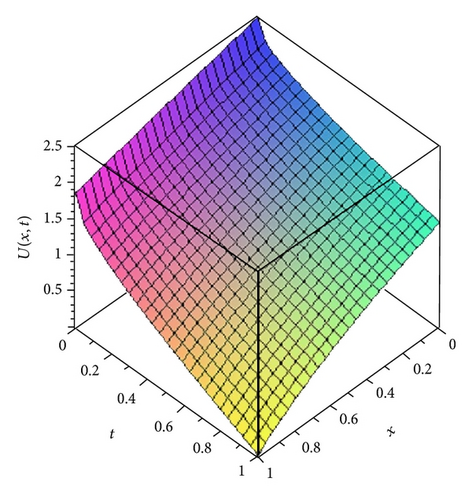
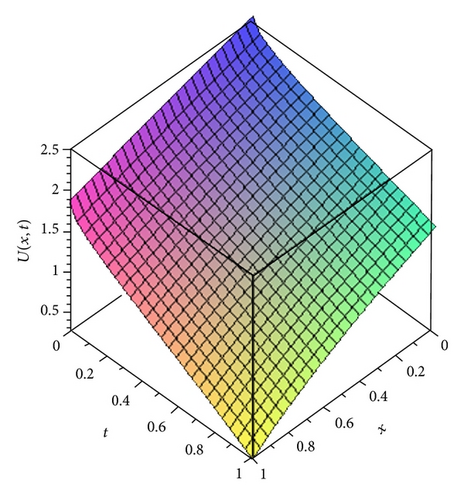
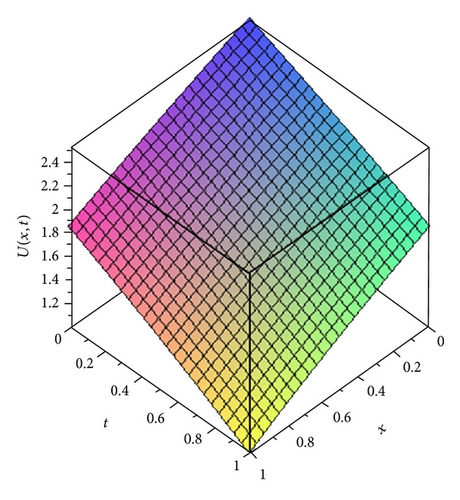
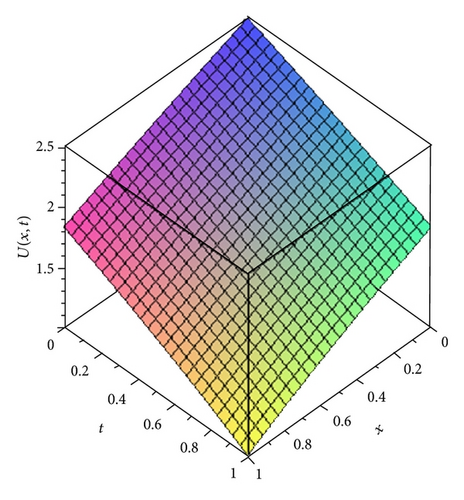
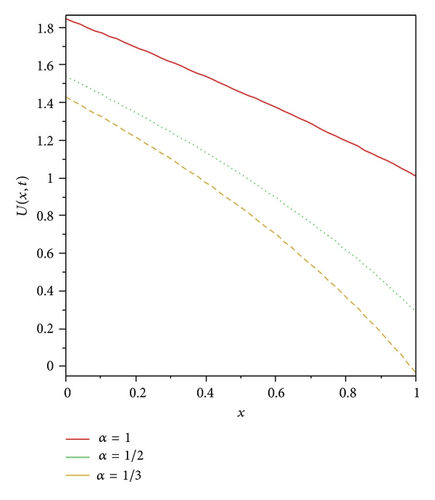
5. Solution by Adomian Decomposition Method (ADM)
5.1. Basic Idea of ADM
5.2. Solution of the Problem
From Table 1, it is observed that the values of the approximate solution at different grid points obtained by the HPSTM and ADM are close to the values of the exact solution with high accuracy at the third term approximation. It can also be noted that the accuracy increases as the order of approximation increases.
| x | t | HPSTM | ADM | Exact solution |
|---|---|---|---|---|
| 0 | 1 | 1.843946953 | 1.843946953 | 1.843946953 |
| 0.2 | 1 | 1.694117377 | 1.694117377 | 1.691538112 |
| 0.4 | 1 | 1.537581542 | 1.537581542 | 1.534036644 |
| 0.6 | 1 | 1.373028020 | 1.373028020 | 1.367980757 |
| 0.8 | 1 | 1.198654865 | 1.198654865 | 1.191138425 |
| 1.0 | 1 | 1.011880649 | 1.011880649 | 1.000000000 |
6. Conclusions
In this paper, the homotopy perturbation sumudu transform method (HPSTM) and the Adomian decomposition method (ADM) are successfully applied for solving nonlinear time-fractional Harry Dym equation. The comparison between the third order terms solution of the HPSTM, ADM, and exact solution is given in Table 1. It is observed that for t = 1 and α = 1, there is a good agreement between the HPSTM, ADM, and exact solution. Therefore, these two methods are very powerful and efficient techniques for solving different kinds of linear and nonlinear fractional differential equations arising in different fields of science and engineering. However, HPSTM has an advantage over the Adomian decomposition method (ADM) such that it solves the nonlinear problems without using Adomian polynomials. In conclusion, the HPSTM may be considered as a nice refinement in existing numerical techniques and might find wide applications.
Acknowledgments
The authors are very grateful to the referees for their valuable suggestions and comments for the improvement of the paper. The third author also gratefully acknowledges that this research was partially supported by the University Putra Malaysia under the Research Universiti Grant Scheme 05-01-09-0720RU and the Fundamental Research Grant Scheme 01-11-09-723FR.




